|

Headwear
of the Middle Ages
CHAPLETS & GARLANDS - FILLETS, BARBETTES &
TORQUES
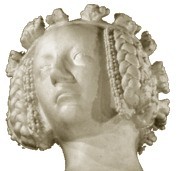 As
one might imagine, a woman's outfit was not complete without some
kind of headwear. As with today, a medieval woman had many options-
from straw hats, to hoods to elaborate headpieces. A woman's activity
and occasion would dictate what she wore on her head. As
one might imagine, a woman's outfit was not complete without some
kind of headwear. As with today, a medieval woman had many options-
from straw hats, to hoods to elaborate headpieces. A woman's activity
and occasion would dictate what she wore on her head.
The middle ages, particularly the 14th and 15th centuries, were
home to some of the most outstanding and gravity-defying headwear
in history.
Before the hennin rocketed
skywards, padded rolls and truncated and reticulated headdresses
graced the heads of fashionable ladies everywhere in Europe and
England. Cauls, the cylindrical cages worn at the side of the
head and templers added to the richness of dress of the fashionable
and the well-to-do. Other more simple forms of headdress included
the coronet or simple circlet of flowers. This page is broken
into six sections:
COIFS
CROWNS,
CORONETS & CIRCLETS
HATS
& HENNINS
HEADDRESSES
A look at some of the fantastic headdresses of the middle ages-
crespines & cauls, templers & bosses, cylinder cauls,
horned headdresses, padded rolls and heart-shaped headdresses
VEILS
& WIMPLES
No, not just for nuns, keep the sun off and be stylish! Frilled,
goffered, edged, layered, veils, gorgets and wimples.
HOODS
Keeping toasty warm in a medieval winter

Chaplets
and Garlands
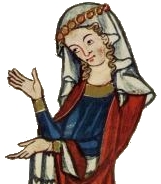 In
Anglo-Saxon times, garlands of flowers were worn by both sexes
on festive occasions such as May Day, Whitsun and weddings. This
trend continued right through to the mid 14th century. In
Anglo-Saxon times, garlands of flowers were worn by both sexes
on festive occasions such as May Day, Whitsun and weddings. This
trend continued right through to the mid 14th century.
The expression chapeau de fleurs or 'hat of flowers' did
not mean literally any form of hat, but simply a circlet of forget-me-nots
or roses, which was deemed an indispensable part of dress for
balls or festivities from early in the medieval period.
Eleanor of Province introduced
the fashion of gold or silver imitation flowers, which were often
set with clusters of jewels or enamels. These ornate floral wreaths
were popular with noble ladies. These fine, metalwork circlets
were called guirlands or garlands for worn for special
events.
These had the advantage of not fading and of providing an opportunity
to display a costly dress accessory to others.
In their book, Dress in
the Middle Ages, Francois Pipponier & Perrine Mane write
that a woman needed money to put up a good show on their wedding
day, and also for the purchase of a jewelled, or imitation jewelled,
chaplet or garland to wear on their head. 

Fillets,
Circlets and Torques
Around the 12th century, the fillet, torque or toque was nothing
more than a stiff, narrow band of cloth used to secure a woman's
veil. It is widely seen on statues throughout the early medieval
period.
These days we usually refer to them collectively as circlets.
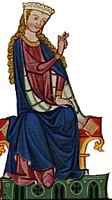 Shown
at the right is dated between 1340 and 1360 of the Madonna
and Child. Shown
at the right is dated between 1340 and 1360 of the Madonna
and Child.
Eventually the fillet widened
into a stiffened linen band which could be about 2 to 2 and a
half inches in width. A working class woman might have a smaller,
simple white linen one to secure her veil.
An upper class woman would certainly have taken the opportunity
to embroider and work pearls and jewels into her headband.
Royal and noble ladies placed their coronets or circlets round
the rim when wearing them on any important occasion. An excerpt
from Manners, Customs, Dress In the Middle Ages by Paul
Lacroix states-
Frontlets or fronteaux,
a species of fillet made of silk, covered with gold and precious
stones, superseded the chapeau de fleurs, as they had the advantage
of not fading. They also possessed the merit of being much more
costly, and were thus the means of establishing in a still more
marked manner distinctions in the social positions of the wearers.

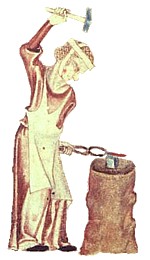 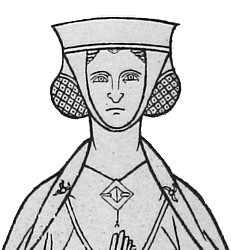 Barbettes Barbettes
It was common for the fillet to worn as a foundation for the veil
to be pinned to. A narrow chin band was usually adopted which
was called a barbette. Knotted mesh hairnets became a part
of the usual headdress for English women in the 13th century.
At this time, many contemporary images show the hair loose and
flowing, such as seen in manuscripts of the 14th century such
as the Manesse Codex, shown at top left. These women were
more than likely young and unmarried.
It was usual for the hair to be modestly contained within the
hairnet, fillet and barbette together as a set.
The detail at left of a woman blacksmith comes from the Holkham
Bible dated in the 1330s. It shows how a working class woman
would have worn the coif, fillet and barbette in a workplace environment
to keep her hair secured while she worked.
The filet and barbette gradually
became less popular in the early part of the 14th century in favour
of plaits worn on each side of the face, a French fashion which
evolved before the end of the 13th century.

Copyright
© Rosalie Gilbert
All text & photographs within this site are the property of
Rosalie Gilbert unless stated.
Art & artifact images remain the property of the owner.
Images and text may not be copied and used without permission.
|